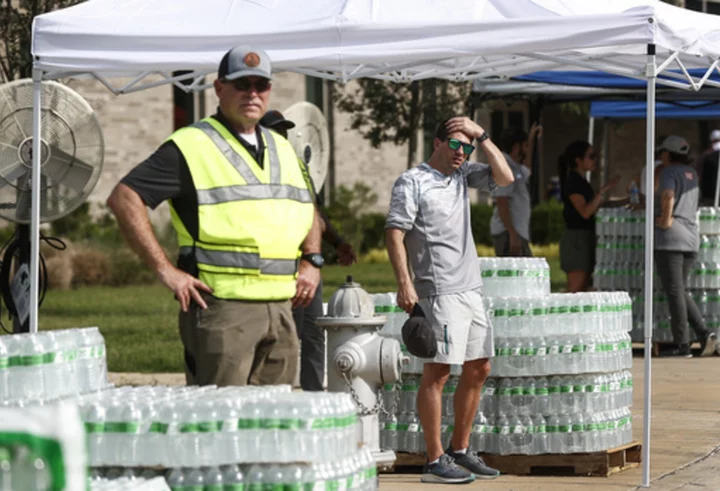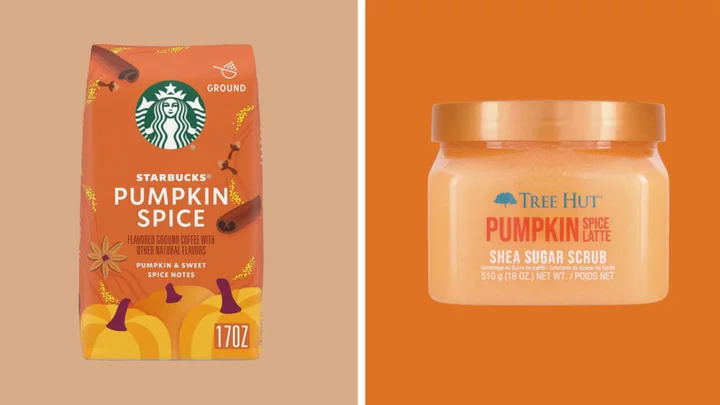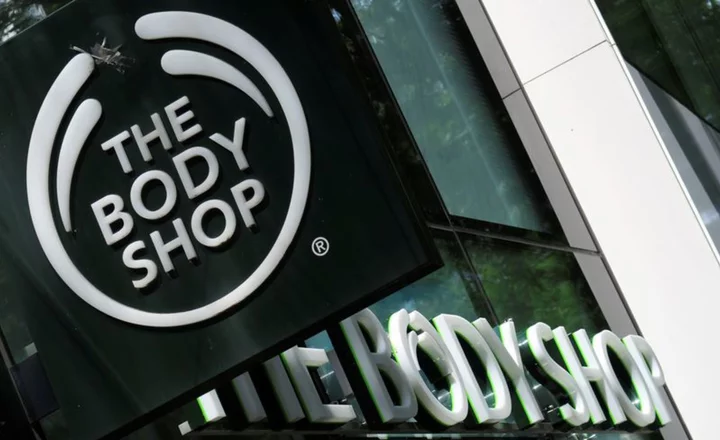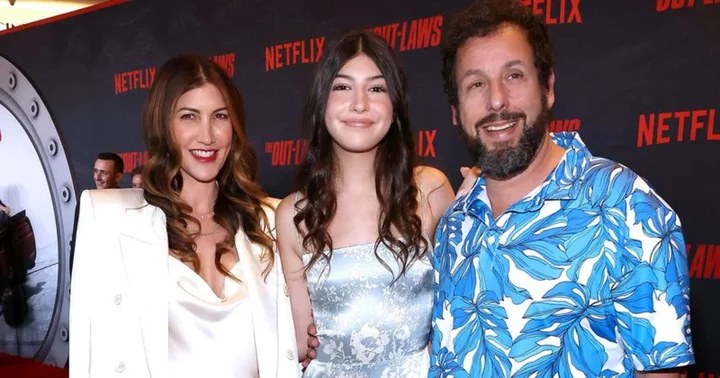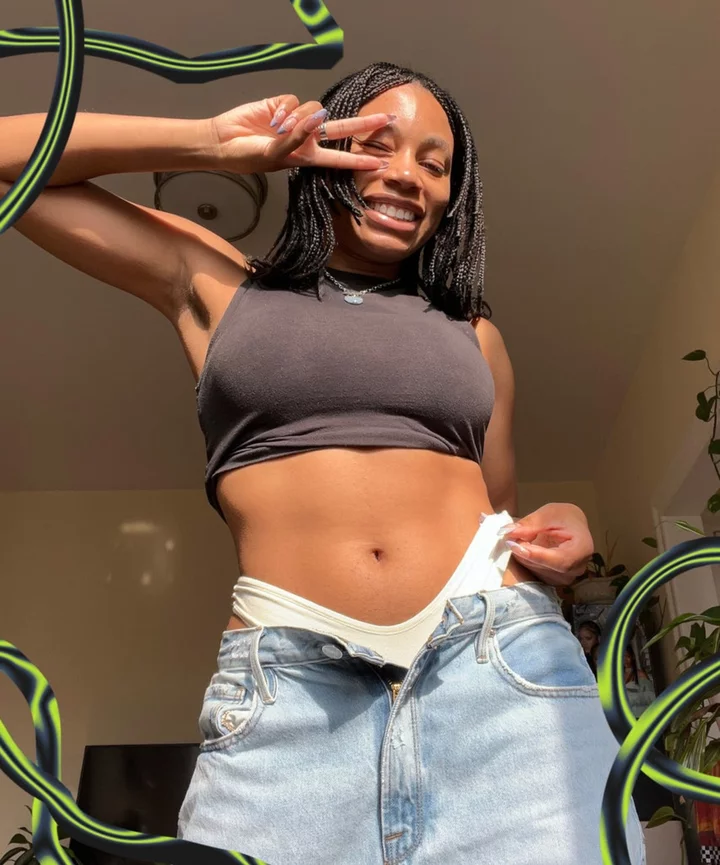There's a bird roosting outside of designer Daniel Silverstein's white-trimmed window, peeking into the animated tableau ensconced in a bright corner art studio on the third floor of a sticker-plastered Bushwick building.
The bird, holding white fibers in its beak, moves its head beyond the glass in fidgety movements that mirror the in-out, start-stop motions of Silverstein's sewing machine. It’s hard to say what the bird is eyeing — maybe its own reflection in the pane — but it's easy to think it might be envious of the dozens of jars replete with material odds and ends lining Silverstein's west wall. One jar holds old clothing labels, another enshrines bits of plastic, several are packed with strips and scraps of fabric.
Zero Waste Daniel’s headquarters displays the byproducts of the fashion industry as art. Credit: Molly FloresOnly a few feet away from that NYC pigeon, Silverstein is building his own space, a nesting ground for his future in the tumultuous fashion industry, defined by his interests in experimental art, environmental conservation, and queer and gender-neutral aesthetics.
He's the mind behind Zero Waste Daniel, a handmade fashion brand focused on sustainability through the use of discarded scrap fabrics shed off or donated by the larger fashion industry, and his sustainable-forward work was first featured by Mashable in a 2018 mini doc, exploring the way brands like his modeled a revolutionary alternative to the fashion industry's excessive waste and consumption. At the time, Silverstein was in the middle of a storm of coverage, including features in Insider and the New York Times, highlighting his innovative "re-roll" technique, which informs the patchwork fabric style still characteristic of his brand today.
A fashion school grad, Silverstein now hopes to influence the next generation of out-of-the-box designers. Credit: Molly FloresHis priorities — like many of the rest of the world — have since shifted. Silverstein and his business partner and husband, Mario DeMarco, closed their retail storefront during the pandemic, and Silverstein reframed his social media presence from brand-building sales account back to a social networking-only hobby, at the suggestion of his therapist. He's taken the term "slow-fashion" quite literally, his handmade designs part of a personal and professional recalibration.
At the time of this interview, that involved Silverstein hand-sewing several comically-large stuffed arms, fashioned in a pastiche of red, hot pink, and mauve textiles.
Zero Waste Daniel is a brand built on disruption. Credit: Molly Flores"I really love what I call narrative fashion — pieces that are, as some people would say, statement pieces," Silverstein explained while attaching red fabric to a limb armature padded with 6-year-old recycled white tulle from designer Jaclyn Jordan, who used to share a coworking space with Silverstein.
The looks of "Strange Love" combine oddball aesthetics with familiar materials and motifs. Credit: Molly Flores"A statement piece could be anything. I really love pieces that legitimately tell stories or start conversations. I have said before that I specialize in 'Best Night of Your Life' clothing. Don't you dare wear a Zero Waste Daniel outfit and expect not to get stopped on the street. I am someone who is always searching for a deeper understanding of my 'why' and I put that into my designs."
Outfitting the absurd drag of "Strange Love"
Adorned in pink, "Strange Love" is Oddly's lip-synced, relatable, personal story. Credit: Sidra GreeneThe femininely Frankensteined limbs are part of an at-the-time secret project with drag performer Yvie Oddly, the winner of Season 11 of international favorite RuPaul's Drag Race and an All Stars contestant on the show's best-of-the-best spin-off competition. Silverstein's custom collection, full of huge, show-stopping pieces and surrealist takes on classic bikinis and overcoats, will become the visual centerpiece of Oddly's revamped "Strange Love" tour, a one-woman show that debuts in November and will travel around the country.
"We're telling a whole story. It's four looks that are related and come apart and touch each other. It's sort of a Russian nesting doll — reveal after reveal after reveal," Silverstein explained at an early design session in April. "She is mixing everything that is weird about her with a very relatable topic in an elevated, glamorous approach." Oddly gave a sneak peek of the wardrobe one month later, at a one-night-only performance at Rocco's Weho nightclub in Los Angeles, California.
Credit: Sidra Greene Credit: Sidra Greene Credit: Sidra Greene Credit: Sidra Greene"I feel like her drag persona allows me to tap into stuff that I love that other people are scared of and that other people can't handle," Silverstein said. "You want to be transported to a new place just looking at what she's showing up in. That is the sweet spot for me. I love glamour and I love classic fashion and I love all of those things, but where I'm most comfortable is taking risks. Yvie allows me to take risks and throw stuff at the wall and see what will stick."
Growing into a more tailored fit
Silverstein and DeMarco have adorned their business headquarters with mementos chronicling their brand and personal partnership. Credit: Molly FloresLike the upcycled outfits on stage and much of the designer's brand, the Silverstein-Oddly duo is a kind of mix-and-match artistic powerhouse, an experiment in the limits and potential of fashion, and, in some ways, a political activation.
"Fashion week is a circus, and drag is fashion." - Daniel SilversteinSilverstein is a self-professed "messy, Bushwick Queerdo," a former contestant of reality fashion design show Fashion Star and intern for big industry names like Carolina Herrera. His designs have since been worn by celebrities such as Jennifer Hudson, Kristen Bell, and Ilana Glazer, and he's the sartorial force behind collaborations like that between actor Fran Drescher and consignment brand ThredUP. Oddly is a crowned drag legend, artist, and musician bedazzled with piercings and a scrawled "Queerdo" tattoo on her head in a personal proclamation.
Silverstein's brand identity, as well as the new partnerships and collections he's intentionally choosing, exists in direct opposition to the industry status quo.
Credit: Molly Flores"The biggest stars in the world, all of the major celebrities and celebrity brands, people who we thought would never be on TikTok, are on TikTok pushing things. To me that almost indicates a failure. The system, the success, the money, the fame — it's never enough. You have to get on the latest platform and pander," Silverstein said. "Even though you want to participate, you have to be hyper-aware of what your definition of success is. Otherwise, you're just in the rat race."
In renegotiating what growing a brand looks like in service of sustainability, Silverstein has had to come to terms with how his work fits into new forms of online behavior and their real-world implications, and the way his oddball status in the fashion industry dovetails with his spot in the queer community.
Silverstein's fashion story, from sustainable star to drag couturier, is still evolving. Credit: Molly Flores"We have to keep moving, but moving doesn't necessarily mean getting bigger. Growing doesn't necessarily mean getting bigger, either," Silverstein reflected, a nod to his place in the aforementioned slow fashion shift.
"It used to be that I wanted to dress red carpet celebrities. Everyone's looking at the Met ball and everyone's looking at the Oscars," he said. "I don't even want to look there because they're just following each other's trends. They're not into sustainability, but they're recycling each other's stuff."
Oddly, meanwhile, is on her own mission to upend the pop-culture norm, planting herself firmly on the feeds of social media users in a defiant, anti-capitalist outcry against her own path to success and the well-worn, multi-million-dollar drag franchise.
As drag has gone mainstream, artists and performers reimagine the stage show and its cultural impact. Credit: Molly FloresTogether, they bold their names in their respective industries, serving up a colorfully oppositional stance to their onlookers that says fashion can still be revolutionary, for the planet, its people, and those in power who refuse to listen.
All hands on deck: A collaboration by and for chosen community
Credit: Molly FloresThe main vehicle for this mission is, in the eyes of the two creatives, drag performance itself. And the soul of the movement blooms in conversations taking place in spaces like the Zero Waste Daniel studio.
"I started thinking, 'Where are the real innovators? Where are the people doing things that no one else is doing? Who's taking the risks?'" Silverstein explained. "In our current culture, drag queens are the new couture customer. They are the only people who are buying stuff. They are the only people who are wearing things that no one else is willing to wear because they don't have the courage, the vision, the imagination, or the occasion."
Silverstein felt he had to take a risk ("I'm a schemer.") So he reached out to a group of his favorite drag queens for a proposed Earth Day 2021 campaign. He'd design custom outfits, using his sustainable brand, for them to post online and drum up excitement for their favorite Earth Day causes. They all said yes.
Overnight, he became designer to other RuPaul's Drag Race icons like Shea Couleé, Jinkx Monsoon, Bob the Drag Queen, and Crystal Methyd. Couleé's gown would later be featured in Vogue. His relationship with New York City's Broadway community came in handy too, connecting him to a community of thespians like barrier-breaking actor and drag performer Peppermint.
Zero Waste Daniel’s “Wall of Fame” tells a story of queer art and community. Credit: Molly Flores"They're the only people who really understand what it means to be so far outside the norm that you either show up with gusto or you don't show up at all," Silverstein lauded. "Now, after decades, drag is having its moment on top. It is really the pinnacle of art and fashion merging. Fashion week is a circus, and drag is fashion."
SEE ALSO: Emira D'Spain's rose-colored glasses are both a fashion accessory and a way of lifeAt a fitting for "Strange Love," Oddly and Silverstein worked together to take the designer's bright sketches into a costumed reality fit for the nightclub, Oddly whipping out a new strap-on prop that would cheekily pop out of Silverstein's multi-limbed design at the end of the show. "All hands on deck!" Oddly animatedly voiced before disrobing for the fitting.
Silverstein first dressed the drag star in a lace white babydoll dress and pink and red overcoat (which, he reassured the room, still needed a mammoth bow attached to the back). That was followed by an hour of careful placement for each of the previously-sewn arms, caressing each other in a jaw-dropping bikini form that literally uncovers Oddly's body for the crowd. "Calm down!" Oddly yelled playfully at a hand covering the left side of her chest.
Credit: Molly Flores Credit: Molly Flores Credit: Molly Flores Credit: Molly Flores"The basis of where this came from, the whole conversation about all of these outfits, was wanting to do something that is very burlesque, but incorporating ideas or inspiration or fashion in a way that is not so traditionally burlesque. It's not something I have a lot of professional experience in, but it has always been a part of my drag," Oddly explained. "So when [Silverstein] came to me with the hands idea, I was like, 'That's pretty. That's sexy.' It's fun and flirty, getting to strip off all of these elements, but it's a bunch of fucking clown hands."
Observing from a yellow couch opposite the bird's nest, it's clear to see this is not the duo's first collaboration, draping and pinning in a communication seemingly based more on vibes than words, but it's the next and biggest step in Silverstein's more experimental design run that combines couture with sustainability.
"I just feel like what's exciting about working with you is that most people want something that they've seen, that they understand, and you only want things you haven't seen," Silverstein addressed Oddly, draping hands over her nearly-naked body in front of the studio's bright window and a mirror that reads: "I'm not perfect, but I am beautiful."
If Silverstein imagines himself the Harlequin boy, his designs invite everyone to the ball. Credit: Molly Flores"Yeah! That's kind of the point of it all," Oddly concisely replied.
During the session, Silverstein and Oddly went back and forth with the designs, Silverstein noting the different found fabrics and textures he was using and Oddly talking about the lengths she would go to have a truly unique performance. They bonded over both having sisters: Oddly grew up in a family of five very different half-siblings, while Silverstein's Alaska-based sibling hunts caribou.
Quips about the RuPaul's Drag Race series were thrown back and forth, as well. "It's a brand and franchise that profits off a vision of the future that doesn't always benefit us," Oddly noted, never shy about voicing her criticisms.
Credit: Molly FloresThey also deftly wove together conversational threads that, in any other space, might seem jarring or out of place, but were part and parcel for two "Queerdos" in LGBTQ-dominated artistic spaces.
"My experience in this industry feels like I have become this Harlequin boy, who has taken a piece from everyone and put myself at the party." - Daniel SilversteinA note about Oddly purchasing property for the first time streamlined into a quick conversation about inaccessible financing for small business owners and artists. "It's so funny because everyone's so impressed with your art and then you try and buy anything and they're like, 'Oh, well, we were just kidding,'" Silverstein said.
As a recently-christened poster child for drag, Oddly is solidifying her place in the mainstream conversation. Credit: Molly FloresHe then asked Oddly's advice on finding the best tucking underwear, which led into discussion on making nonbinary models feel comfortable in the fashion world. A minute later, the casual heart-to-heart shifted to Oddly exploring ethical considerations surrounding parenthood, as a queer person facing intersectional stigma.
"There's something poetic to me about the idea of literally choosing, like 'I chose you to be my family,'" the performer mused.
Oddly had opened the fitting chat with a brief, affectionate reflection on her fanbase, which she proudly noted includes many people in the disability community who turn out to her shows in solidarity. The performer's been open about having Ehlers-Danlos Syndrome (EDS), a connective tissue condition that's led to her hypermobile stage style. "I love seeing the first three rows filled with my fellow disabled folk. I'm like, 'Yas! I'll do a backflip just for you — even though I shouldn't.'"
Oddly's drag pushes the boundaries of art and glamour, aided by Silverstein's non-opportunistic fashion. Credit: Sidra GreeneThe conversation wasn't intended to be a quick summary of some of society's most pressing questions, but it certainly mimicked a bullet-point list of issues, from the complexity of taxes to the demands of the fashion industry on gender nonconforming people. Just outside the door, how-to coffee table books on sustainability (A Zero Waste Life in 30 Days and A Zero Waste Family in 30 Days, both by scientist Anita Vandyke) kept a watchful eye, reminding everyone in the room about the brand's mission — and how it all connects together.
Daniel and the Gift of Many Colors
Silverstein's risk-it-all energy shines in his work. Credit: Molly FloresDrag performance and environmental sustainability don't seem like inherently connected issues, but they have been lumped together in conceptualizations of the so-called liberal agenda — two different forms of care and self-expression thrown into a political fun house mirror that's reflected back the beauty of finding and respecting one's place in the world, somehow marred in controversy.
SEE ALSO: Where to find domestic travel guidance in light of safety advisories for marginalized groupsOver the last year, public drag performers have been targeted by restrictive bills banning their deeply historic form of art, as LGBTQ communities face broadly sweeping legislation across the country. Clothing and gender presentation are once again political statements, a form of unique expression that on one hand sets the wearer apart from the masses and yet connects them to an already-established community. And the fate of the world in our current climate crisis is an ever-looming, generation-defining question.
Credit: Sidra Greene Credit: Sidra GreeneIt could be said that the different social causes share at least two things in common: an innovative "finder's" mentality — which sees design creatives like Silverstein reusing fabric scraps and queer artists like Oddly seeking new ways to defy social restriction — and the driving force of human solidarity.
"I hold all of my real body in," Oddly began during one part of the fitting, "so I can be the character for a couple hours," Silverstein finished.
Throughout the multiple atelier sessions, Silverstein had a way of returning to this notion of kaleidoscopic identity, a guidepost for both his brand and drag collaborations. At one point, Silverstein quotes something his father used to tell him: "Never say never, Fievel." Fievel, for those unaware, is the plucky mouse at the heart of 1986 family film An American Tail, who sports a notably patchwork outfit as he makes a new home in New York City.
Silverstein's fashion story, from sustainable star to drag couturier, is still evolving. Credit: Molly FloresAt another point, he told the story of his favorite childhood book, 1973's Harlequin and the Gift of Many Colors by Remy Charlip and Burton Supree. It spins the saga of a poor boy who wants to attend the town's colorful carnival, and gets the radical idea to fashion a new suit out of found fabric he's been gifted from kind townspeople.
"My experience in this industry feels like I have become this Harlequin boy, who has taken a piece from everyone and put myself at the party," Silverstein reflected in his studio, the bird behind him long gone. "It's kind of sweet and feels like a romanticized version of my reality, but at the same time it speaks to the idea that you don't need all the money and all the access, you just need the idea and the fortitude to get there."
If the "Strange Love" wardrobe could talk, it'd tell a myriad of tales. Credit: Molly FloresSilverstein and Oddly, who is also a Unilever LGBTQ ambassador for 2023, have turned identity-building and social justice into a bare-it-all stage show — not the superficial "performance" of cause and care that's rampant on the social media Silverstein is slowly but surely giving up, but the good kind. The kind of visual showboating that stirs the imagination, fires up one's emotions, and questions the status quo. The kind of performance that suggests there's more than one option for being.
Through it all, Silverstein credits the course of his career, and his life, with a quote from one of his professors at New York's Fashion Institute of Technology (FIT).
"He said, 'There's two kinds of designers, good designers and great designers. Good designers see their work coming and going and in the pages of magazines and in store windows. Great designers change the way people dress.' I had to figure out what being a great designer meant for me," Silverstein recalled. "I knew that was my goal, but I didn't know what fashion needed. What I learned it really needed was a massive paradigm shift.
A bundle of arms wait for their big day under the spotlight, Silverstein their anatomical guide and Oddly their proud model. Credit: Molly Flores"Rather than a new hemline or a color of the season, we need to make doing the right thing fashionable."
For more Social Good stories in your inbox, sign up for Mashable's Top Stories newsletter today.


